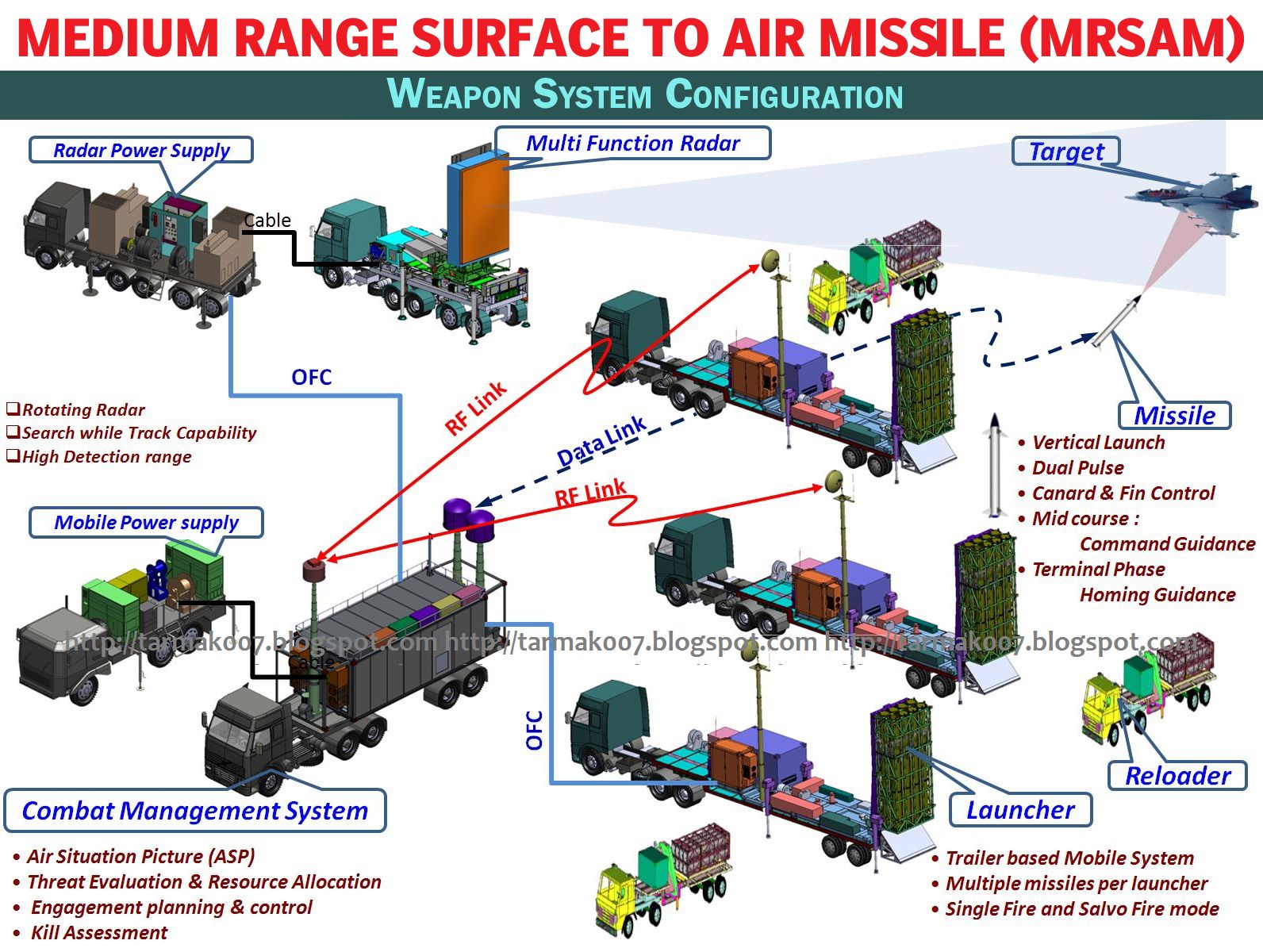Water Car Engineer
ELITE MEMBER

- Joined
- Sep 25, 2010
- Messages
- 13,313
- Reaction score
- 8
- Country
- Location
Bangalore/Hyderabad: The Medium Range Surface to Air Missile (MRSAM) – an Indo-Israeli joint weapon system development project -- undertaken by the Defence Research and Development Organisation (DRDO) along with the Israel Aerospace Industries (IAI), sees to have finally picked up momentum. Billed to replace the aging and outdated Pechora SAM systems, currently being used by the Indian Air Force (IAF), the project promises to deliver over 450-plus MRSAMs and 18 firing units at an approved cost of Rs 10,075 crore.The MRSAM system has an intercept range of 70 km for a fighter class aircraft target.
The missile carries an active radar seeker, dual pulse rocket motor for effective end game, and a bi-directional data link for mid-course guidance and kill assessment. It is also equipped with a modern ground-based multi-function 3D rotating active phased array radar (with multi beam electronic scanning capability) to provide high quality Air Situation Picture (ASP) and weapon support under adverse operational and environmental conditions (capable of operating at extreme condition of -30deg C, altitude of 3.5 km).
Sources tell Express that once operational, the MRSAMs will be the best bet for an effective air defence of vital areas/vital points (VAs/VPs) in the Indian sub-continent. "The ground based radar of the MRSAM system has a robust ECCM (electronic counter-counter measures) features. It detects very low RCS (radar cross-section) targets in complex, cluttered and jamming environment while simultaneously performing long-range surveillance, target classification and multi-target engagement. It is capable of neutralizing a variety of aerial threats and operates on a network-centric command and control architecture," sources claim.
The weapon system can operate on standalone mode or joint targeting mode using network centric concept, while having the combined ASP from all the existing sensors of the air defence system. "The system can also be integrated with air-borne platforms like Air-borne Warning and Control Systems (AWACS) for centralized command and control. DRDO will develop the rear section of the MRSAM, while the IAI will pitch in with the technologies for the front part," sources said.
It is for the first time that a joint-development project has been sanctioned with a commitment to deliver the system within a short time. Presently the weapon system is in the development phase with the preliminary, detailed and critical design reviews completed. Realisation of the prototype hardware has also been initiated for development trials.
Though behind schedule, owing to technological challenges faced during the development phase, the trials of MRSAM system are likely to take place in 2013-2014 and the induction of the first firing unit into the Services, now planned in the third quarter of 2014.
Tarmak007 -- A bold blog on Indian defence
The missile carries an active radar seeker, dual pulse rocket motor for effective end game, and a bi-directional data link for mid-course guidance and kill assessment. It is also equipped with a modern ground-based multi-function 3D rotating active phased array radar (with multi beam electronic scanning capability) to provide high quality Air Situation Picture (ASP) and weapon support under adverse operational and environmental conditions (capable of operating at extreme condition of -30deg C, altitude of 3.5 km).
Sources tell Express that once operational, the MRSAMs will be the best bet for an effective air defence of vital areas/vital points (VAs/VPs) in the Indian sub-continent. "The ground based radar of the MRSAM system has a robust ECCM (electronic counter-counter measures) features. It detects very low RCS (radar cross-section) targets in complex, cluttered and jamming environment while simultaneously performing long-range surveillance, target classification and multi-target engagement. It is capable of neutralizing a variety of aerial threats and operates on a network-centric command and control architecture," sources claim.
The weapon system can operate on standalone mode or joint targeting mode using network centric concept, while having the combined ASP from all the existing sensors of the air defence system. "The system can also be integrated with air-borne platforms like Air-borne Warning and Control Systems (AWACS) for centralized command and control. DRDO will develop the rear section of the MRSAM, while the IAI will pitch in with the technologies for the front part," sources said.
It is for the first time that a joint-development project has been sanctioned with a commitment to deliver the system within a short time. Presently the weapon system is in the development phase with the preliminary, detailed and critical design reviews completed. Realisation of the prototype hardware has also been initiated for development trials.
Though behind schedule, owing to technological challenges faced during the development phase, the trials of MRSAM system are likely to take place in 2013-2014 and the induction of the first firing unit into the Services, now planned in the third quarter of 2014.
Tarmak007 -- A bold blog on Indian defence



 Only 450 missiles!!!
Only 450 missiles!!! 






